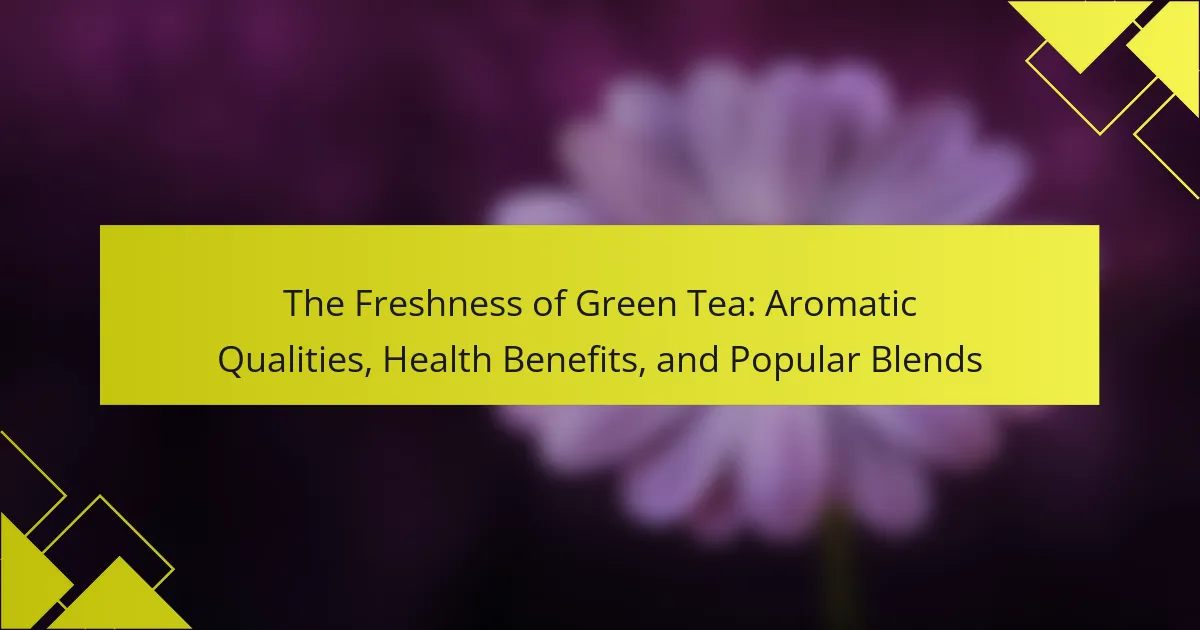
What is Patchouli and Why is it Significant?
Patchouli is a flowering plant from the mint family, known scientifically as Pogostemon cablin. It is significant due to its essential oil, which is widely used in perfumes, incense, and aromatherapy. The oil has a distinct earthy and musky aroma that is highly valued in the fragrance industry. Historically, patchouli has been used in traditional medicine and as a natural insect repellent. Its popularity surged in the 1960s and 1970s, becoming a symbol of the counterculture movement. Today, patchouli oil is also recognized for its potential therapeutic properties, including anti-inflammatory and antidepressant effects. Its versatility makes it a staple in both natural and synthetic fragrance formulations.
How is Patchouli Extracted and Processed?
Patchouli is extracted primarily through steam distillation of its leaves. This method involves steaming the leaves to release essential oils. The steam carries the oils, which then condense back into liquid form. The resulting product is collected and often filtered. Patchouli oil can also be extracted using solvent extraction, though steam distillation is the most common method. The quality of the oil can vary based on the plant’s age and the distillation process. Freshly harvested leaves yield a more potent oil. Additionally, the processing conditions, such as temperature and duration, can affect the final scent profile.
What are the different methods of extracting Patchouli oil?
The different methods of extracting Patchouli oil include steam distillation, solvent extraction, and cold pressing. Steam distillation is the most common method. It involves passing steam through the plant material, which vaporizes the essential oil. The vapor is then cooled, condensing back into liquid form. Solvent extraction uses chemical solvents to dissolve the oil from the plant material. This method is often used for delicate flowers where steam distillation may not be suitable. Cold pressing is less common for Patchouli but involves mechanically pressing the plant to release the oil. Each method yields different qualities of oil, impacting fragrance and therapeutic properties.
How does the extraction method affect the quality of Patchouli?
The extraction method significantly influences the quality of Patchouli. Different methods such as steam distillation, solvent extraction, and CO2 extraction yield varying qualities. Steam distillation is the most common method, producing high-quality oil with a rich aroma. Solvent extraction, while capturing more fragrance components, can introduce impurities. CO2 extraction offers a pure product with a fuller scent profile. Studies show that steam-distilled Patchouli oil has a higher concentration of desirable compounds like patchoulol. The extraction method, therefore, directly affects the chemical composition and overall quality of the final product.
What are the Distinctive Characteristics of Patchouli?
Patchouli is a fragrant herb known for its distinctive earthy aroma. It belongs to the mint family and is native to Southeast Asia. The essential oil extracted from patchouli leaves has a rich, musky scent. This scent becomes more pronounced with aging. Patchouli oil is often used in perfumes and incense. It is recognized for its grounding and balancing properties in aromatherapy. The plant can grow up to three feet tall and has broad, dark green leaves. Patchouli thrives in humid and tropical climates, which contribute to its unique scent profile.
What are the key aromatic notes found in Patchouli?
The key aromatic notes found in Patchouli include earthy, woody, and sweet characteristics. Earthiness is the dominant note, providing a grounding effect. Woody notes add depth and richness to the aroma. Sweet undertones contribute a warm and inviting quality. Additionally, there are hints of spice and musk that enhance the complexity. These notes are derived from the leaves of the Pogostemon cablin plant. Patchouli oil is often used in perfumes and aromatherapy for its distinctive scent. Its unique profile has made it a staple in fragrance compositions since the 19th century.
How does Patchouli’s scent profile evolve over time?
Patchouli’s scent profile evolves through distinct stages. Initially, it presents a strong, earthy aroma with sweet, musky undertones. As it develops, the scent becomes richer and more complex. The initial sharpness softens, revealing deeper woodsy and herbal notes. Over time, the fragrance can take on a slightly balsamic quality. This evolution is influenced by factors such as aging and the medium in which it is stored. Patchouli oil, when aged, often develops a smoother, more refined character. This change is due to the oxidation of compounds within the oil. The scent’s longevity is notable, often lasting for several hours on the skin.
What Historical Context Surrounds Patchouli?
Patchouli has a rich historical context that dates back to ancient civilizations. It originated in Southeast Asia, particularly in India and Indonesia. Patchouli leaves were used in traditional medicine and as a textile preservative. The 19th century saw its rise in popularity in Europe, especially during the Victorian era. It was often associated with the hippie movement in the 1960s, symbolizing peace and love. The distinct scent became a hallmark of counterculture. Patchouli’s historical significance is evident in its enduring presence in perfumery and aromatherapy today.
How has Patchouli been used in traditional cultures?
Patchouli has been used in traditional cultures primarily for its aromatic properties. In ancient India, it was used in rituals and ceremonies for its calming effects. Patchouli leaves were often incorporated into incense to purify spaces. In Southeast Asia, it played a role in traditional medicine, believed to treat various ailments. The plant was also used in textiles to repel insects, particularly in the trade of silk. Historical records indicate that patchouli was essential in the perfume industry during the 19th century. Its distinctive scent became associated with the hippie movement in the 1960s, symbolizing peace and love. This cultural significance continues to influence its use today in various forms.
What role did Patchouli play in the 1960s counterculture movement?
Patchouli was a significant symbol in the 1960s counterculture movement. It represented rebellion against conventional societal norms. The scent was commonly used by hippies and those embracing alternative lifestyles. Patchouli oil was often associated with peace, love, and a connection to nature. Its earthy aroma became a popular fragrance among counterculture participants. Many believed it had spiritual and healing properties. The use of patchouli reflected a desire for authenticity and natural living. This connection to the counterculture solidified its place in the era’s identity.

How is Patchouli Used in Modern Applications?
Patchouli is used in modern applications primarily for its fragrance in perfumes and cosmetics. It serves as a base note in many scent formulations. Additionally, patchouli oil is utilized in aromatherapy for its calming properties. It is often added to candles and incense for its earthy aroma. The oil is also used in skincare products for its potential benefits to skin health. Furthermore, patchouli is incorporated into household products for its insect-repelling qualities. Research indicates that patchouli oil has antimicrobial properties, making it useful in various formulations. These diverse applications highlight patchouli’s significance in contemporary wellness and beauty industries.
What are the Common Uses of Patchouli Today?
Patchouli is commonly used in aromatherapy, perfumes, and cosmetics today. In aromatherapy, patchouli oil promotes relaxation and alleviates stress. The fragrance is popular in the perfume industry for its earthy and musky scent. Many cosmetic products incorporate patchouli for its potential skin benefits. Additionally, patchouli is used in incense and candles for its calming properties. Its historical significance as a fragrance in traditional cultures continues to influence modern usage. The essential oil is also utilized in natural cleaning products for its antimicrobial properties. These diverse applications highlight patchouli’s versatility and enduring appeal.
How is Patchouli incorporated into perfumes and fragrances?
Patchouli is incorporated into perfumes and fragrances as a base note. It provides depth and richness to scent compositions. The oil is extracted from the leaves of the patchouli plant through steam distillation. This process yields a strong, earthy aroma that enhances other fragrance elements. Patchouli blends well with floral, woody, and citrus notes. Its lasting power makes it a popular choice in both high-end and commercial perfumes. Historically, patchouli has been used in perfumery since the 19th century, often associated with exoticism. Its unique scent profile contributes to its enduring popularity in modern fragrance formulations.
What therapeutic properties does Patchouli possess?
Patchouli possesses several therapeutic properties. It is known for its anti-inflammatory effects. This makes it useful in reducing swelling and redness in the skin. Patchouli also has antifungal properties. It can help combat fungal infections effectively. Additionally, it acts as an antidepressant. This property can enhance mood and alleviate stress. Patchouli oil is often used in aromatherapy for relaxation. Its calming scent supports emotional balance. Research indicates that patchouli oil can promote wound healing. These properties make it a valuable component in holistic health practices.
What Trends are Emerging in the Use of Patchouli?
Emerging trends in the use of patchouli include its incorporation into wellness products and sustainable fashion. The essential oil is increasingly featured in aromatherapy for its calming effects. Additionally, patchouli is gaining popularity in natural perfumes as consumers seek eco-friendly options. The fragrance is also being used in skincare products for its purported anti-inflammatory properties. Recent studies indicate a rise in demand for organic patchouli sourced from sustainable farms. Moreover, the trend of upcycling has led to patchouli being used in artisanal crafts and home decor. These developments reflect a broader shift toward holistic and environmentally conscious lifestyles.
How are sustainability practices influencing Patchouli cultivation?
Sustainability practices are significantly influencing Patchouli cultivation by promoting environmentally friendly farming techniques. These practices include organic farming methods that reduce chemical inputs. By using natural fertilizers and pest control, farmers enhance soil health and biodiversity. Sustainable practices also focus on water conservation and efficient irrigation systems. This minimizes water waste and supports local ecosystems. Additionally, certification programs for sustainable agriculture increase market access and consumer demand for ethically sourced Patchouli. Research indicates that sustainable cultivation can lead to higher yields and better quality oil, benefiting both farmers and the environment.
What innovations are being introduced in Patchouli products?
Patchouli products are introducing innovations such as sustainable sourcing and eco-friendly packaging. Brands are now focusing on organic cultivation methods. This reduces environmental impact and enhances product purity. Additionally, new extraction techniques are improving oil yield and quality. Advanced distillation methods are being implemented to capture the essence more effectively. Some companies are blending patchouli with other essential oils for unique fragrances. These innovations cater to consumer preferences for natural and ethically produced products. Data from the essential oils market indicates a growing demand for such sustainable options.

What Practical Tips Should One Consider When Using Patchouli?
When using patchouli, consider diluting it with a carrier oil before application. This prevents skin irritation and enhances absorption. Use patchouli in aromatherapy by adding a few drops to a diffuser. This method promotes relaxation and reduces anxiety. For fragrance, blend patchouli with complementary essential oils like lavender or cedarwood. This creates a balanced scent profile. Store patchouli oil in a cool, dark place to maintain its potency. Patchouli has a long history of use in perfumes and traditional medicine, which supports its effectiveness.
How can Patchouli be effectively used in daily life?
Patchouli can be effectively used in daily life through various applications. It is commonly used in aromatherapy to promote relaxation and reduce stress. Diffusing patchouli essential oil in a room can create a calming atmosphere. Additionally, patchouli oil can be added to bathwater for a soothing experience.
Using patchouli in personal care products, such as lotions and perfumes, provides a distinctive scent. It also has insect-repelling properties, making it useful in natural pest control. Furthermore, patchouli can be incorporated into homemade cleaning products for its antibacterial properties.
Studies have shown that patchouli oil can enhance mood and alleviate anxiety. This makes it a valuable addition to daily wellness routines. Overall, integrating patchouli into various aspects of life can enhance both physical and mental well-being.
What are some recipes or blends that feature Patchouli?
Patchouli is often used in various recipes and blends for its distinctive earthy aroma. One popular blend is patchouli and sandalwood essential oil, which creates a warm, grounding scent. Another common recipe involves combining patchouli with lavender for a calming effect. Patchouli can also be mixed with citrus oils like orange or bergamot to add a refreshing twist. In perfumery, patchouli is frequently paired with vanilla to create a sweet and earthy fragrance. Additionally, it is used in incense recipes, often blended with myrrh or frankincense. These combinations highlight patchouli’s versatility in aromatherapy and fragrance creation.
What precautions should be taken when using Patchouli oil?
When using Patchouli oil, it is essential to take specific precautions. First, always dilute Patchouli oil with a carrier oil before applying it to the skin. This prevents skin irritation and allergic reactions. Second, conduct a patch test on a small skin area to check for sensitivity. If irritation occurs, discontinue use immediately. Third, avoid applying Patchouli oil to sensitive areas, such as the eyes or mucous membranes. Pregnant or nursing women should consult a healthcare provider before use, as safety during these periods is not well established. Lastly, store Patchouli oil in a cool, dark place to maintain its potency and prevent degradation.
Patchouli, scientifically known as Pogostemon cablin, is a flowering plant from the mint family, renowned for its essential oil used in perfumes, incense, and aromatherapy. This article covers the significance of patchouli, its extraction methods, distinctive characteristics, and historical context, including its role in the 1960s counterculture movement. It also explores modern applications, therapeutic properties, emerging trends in sustainability, and practical tips for using patchouli in daily life. The content aims to provide a comprehensive understanding of patchouli’s versatility and enduring appeal across various industries.



